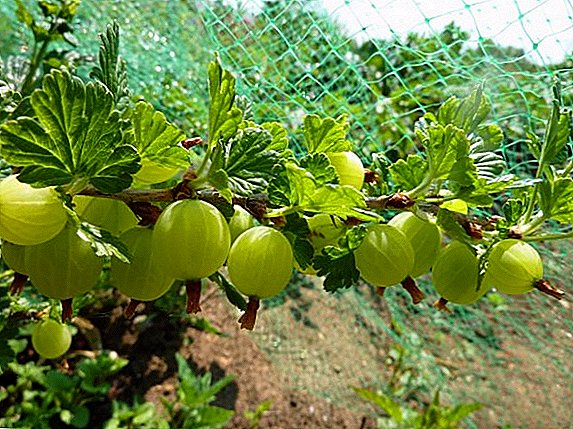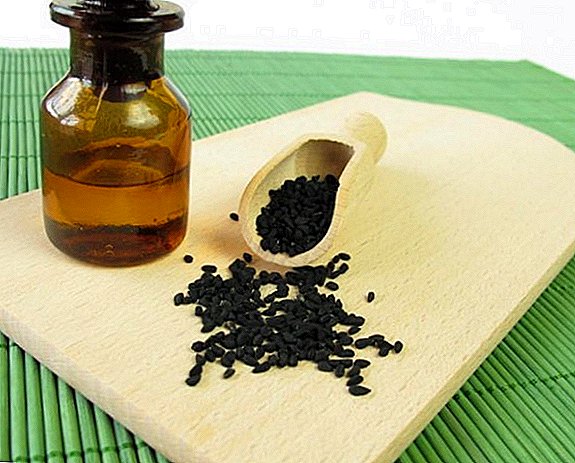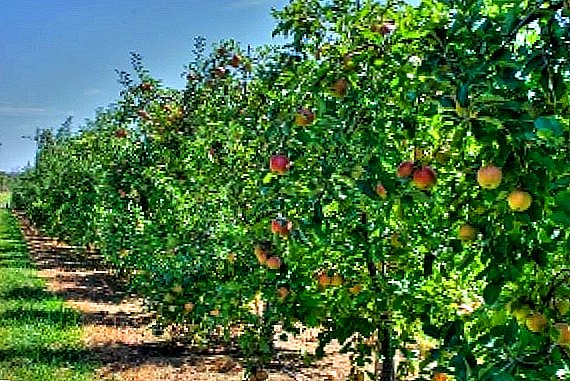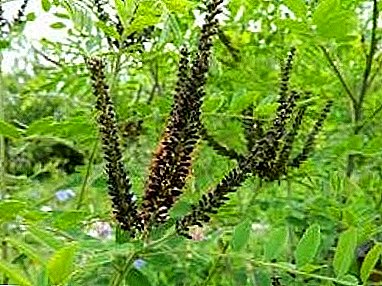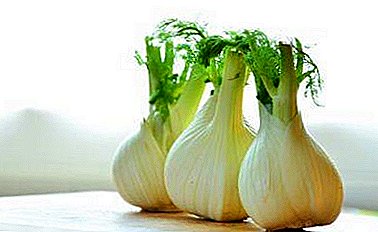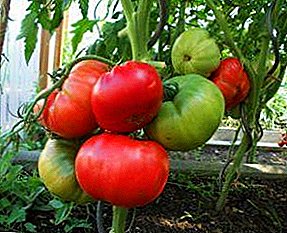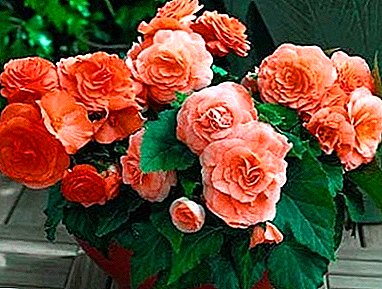
Tuberous begonias (Begonia tuberhybrida) are known for lush abundant blooms, their large double flowers are often compared with peonies. The name of this species is obliged to its tuberous roots.
Care for tuberous begonia at home
Begonia - a simple flower in care, and you will certainly manage to grow a beautiful flowering plant if you follow several rules of cultivation.
What time of year is it best to plant a flower?
Like many other indoor (and not only) plants, begonia is in a dormant period in the autumn and winter. In the spring it enters the growing season, begins to grow rapidly and give new leaves, and in the summer it is blooming with dozens of delicate flowers. When planting, it is necessary to take into account this mode of the plant, therefore plant a tuberous begonia It is best to start at the beginning of March so that it will immediately start active vegetating.
What ground is needed?

In relation to the composition of the earth begonia is not capricious, she will feel good in the usual universal ground, sold in all flower shops. If you still want to prepare your own soil mix, mix four parts of leafy ground, one part of turfy ground and one part of sand. This mixture has a slightly acidic composition, which is ideal for tuberous begonias.
Which pot is better to choose?
The material of the pot does not matter: since the roots of such a begonia have the appearance of tubers, they do not have roots and lint that can cling to the pot and interfere with transplanting. Any pot will do. - ceramic, plastic, even wooden tub. Although most often begonias are planted in plastic pots. But the size of the pot is much more important - it should not be very deep. The tuber should enter the pot so that its third could be seen above the ground, and three to four centimeters should be left from the tuber to the edge of the pot.
The diameter of the pot should be such that from the tuber to the pot on the sides remained about four centimeters.
How to water?
Correct watering - An important part of the care of tuberous begonia.
Begonia in no case can not be watered with cold water, as well as sprayed with a spray.
Recommended watering mode - two or three times a week, evenly distributing the water in the pot. During the flowering period begonia can be watered more often. It is important to prevent stagnation of water, excessive watering will lead to the development of fungi.
What is the optimal light mode?

Begonias - light-loving plants, for their harmonious growth it is necessary to arrange them in a bright place, but not in the bright sun. Begonias feel good on the southeast and southwest windows.
Direct sunlight Leaves can cause burns.
If the sun is too active, you can shade the windows by attaching tulle or gauze to them. The larger the flowers of your begonia, the worse it tolerates bright sunlight.
How and when to trim?
Pruning begonias spend early rest periodwhen the plant has faded and began to shed its leaves (in room conditions, the most suitable time is the beginning of October). Dying off shoots of begonias are cut off in one or two centimeters from a tuber, and then the plant is placed in a cool place at home for autumn and winter.
What thermal regime is needed?
During the growing season, that is, in spring and summer, the temperature in the room should not fall below 12 degrees although begonias suffer badly in extreme heat. The ideal temperature is about 22 degrees. During the rest period, after the plant has faded, and you cut off the dried shoots, the pot is moved to the basement or storeroom.
How does the tuberous begonia reproduce?
There are three main ways of breeding begonias - seeds, dividing the tuber and grafting.
Growing tuberous begonia from seed
It is good that allows you to save varietal characteristics of the flower, but it is a very time consuming process. The purchased seeds are poured onto damp ground without burying, and the pot is covered with plastic wrap. Put in a warm sunny place and sprayed daily. Every day, the pot is opened for an hour to air the seeds and prevent them from rotting from the damp.
In about two weeks, the seeds will sprout. When the sprouts acquire two or three leaves, carefully sit them in small cups.
Tuber division

Most often practiced in the old tubers, because over time the plants will bloom less magnificently. Tuber separation is produced in early spring, when new shoots appear on the tubers. Until they reach 4-5 centimeters in length, you can cut the tuber without damage to the plant. The cut sections are treated so that they do not rot, with a special preparation or powder of charcoal. After that, the tubers are seated in different pots and cared for as full-grown plants.
Reproduction of the begonia of the tuberous cuttings
A very simple and fast way to spread begonia. Cut off the shoot about 10 centimeters long with several sheets.sprinkle the cut with crushed charcoal (to prevent rotting) and root it in a damp earth in a warm bright place.
Planted cuttings must be covered with a glass jar and air daily for an hour so that excess moisture evaporates. After three weeks, the stalk is carefully transplanted into the pot.
How long does a flower live?
Usually, the life of a tuberous begonia is from two to three years, but some varieties can live for five years with proper care. Tuberous begonias, sold in stores for gardenersare repetitive plants. To "rejuvenate" the begonia tuber, divide it into several according to the division method described above.
How and when to feed the plant?
In the spring, when begonia enters the growing season and actively forms new leaves, it is watered with fertilizer, containing nitrogen, two times with an interval of two weeks. To feed the flowering plant, in the summer every two weeks it is fed with fertilizers containing potassium.
Chlorine is harmful to begonias, so be careful when choosing a fertilizer, and also do not forget to defend water for irrigation.
If you are not well versed in fertilizers and trace elements that make up their composition, use one special fertilizer for begonias in spring and summer - so you definitely do not harm your favorite flower.
How to care for begonia tuberous in the fall?

Begonia Autumn there is a period of peace which lasts until spring. At this time, you need to cut off the withered leaves and shoots, reduce watering, the plant is cleaned in a cool place (with a temperature of about 10 degrees) and occasionally gently moisturize the ground.
How long is the flowering period? Of all the begonias, the tuberous is the most decorative, its flowers, depending on the variety, can be simple or double, single-color, two-colored or border, small or large (up to 15 centimeters in diameter). Tuberous begonia pleases with abundant flowering in the garden - throughout the summer, and in room conditions - from June to October. Best begonias bloom on a shaded balcony.
Care and planting of a tuberous begonia in garden conditions
Tuberous begonia is, first of all, a garden plant. If you plan to plant it on your plot, pay attention to several rules of care.
Priming
As in the case of indoor cultivation, in the garden begonia does not require a special composition of the soil. The only condition - the land should be loose.
Choosing a landing site
You can not plant begonias in the scorching sun, diffused light recommended. Flowers feel best on the eastern and western sides of the plot, away from direct sunlight. In the first month after disembarkation of begonias, it is recommended to pritenyat them, to shield them from the bright sun with a piece of greenhouse film.
How to grow this flower in the garden?
Begonia can be planted in the open ground only when the weather is warm - best of all in May. Until this spring, begonias are kept in pots at home or in a greenhouse. On the garden plants look beautiful, planted at a distance of 15-20 centimeters from each other. In the fall, when the begonias fade away and start losing the leaves, they are cut, dug and harvested in a cold place.
Diseases and pests
Begonia is afraid of over-wetting, and therefore dampness can cause to the decay of the roots. Moreover, various fungi can appear in too wet ground. The most common fungus, gray rot, affects the leaves, it can be detected by a gray patina on the upper side of the leaf, and buds are also affected (a mucous plaque appears on them). You can get rid of gray rot, having sprayed the plant with raster soap and copper sulfate (20 grams of soap and 2 grams of vitriol are dissolved in a liter of water). Powdery mildew may also appear from the damp - light gray spots on the leaves. To cope with it is easy - just wipe the leaves with soap and water. Also begonia can hit aphid - a small insect, sucking the juice from the leaves. Aphids can also be removed with soapy water; Special chemicals also help well.
Rot manifests itself in the blackening of the stems, it spreads very quickly. It is important to quickly remove decaying stems to prevent the death of the plant, and to process the flower with a fungicide. Blackening of the stems and leaves can cause bacterial blotch, it begins with the appearance of small vitreous spots on the inside of the leaf. It is useless to fight it, you need to throw away the affected plant and sanitize the ground. To prevent bacterial blotch, begonias are sprayed with copper oxychloride solution.
We hope that these tips will help you grow a healthy tuberous begonia, which over the years will delight you with beautiful lush flowers in the garden or at home.
A photo
Then you can see photos of planting and care at home for Tuberous Begonia:






